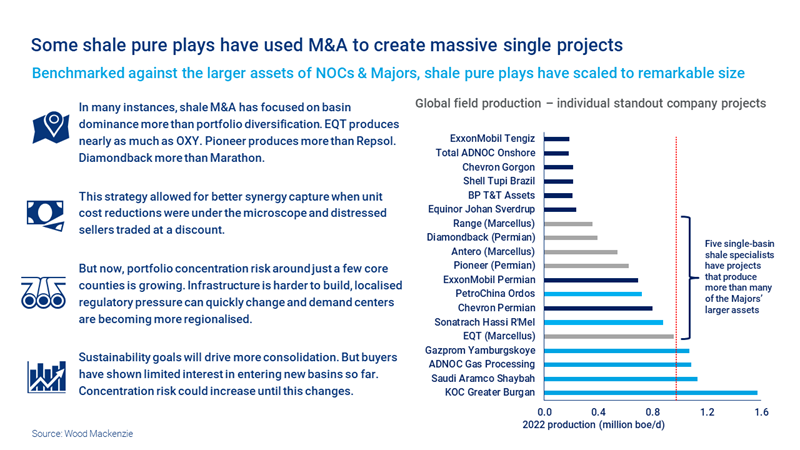Interested in learning more about our gas & LNG solutions?
Balancing scale and concentration risk in US shale
Double down or diversify?
4 minute read
Simon Flowers
Chairman, Chief Analyst and author of The Edge

Simon Flowers
Chairman, Chief Analyst and author of The Edge
Simon is our Chief Analyst; he provides thought leadership on the trends and innovations shaping the energy industry.
Latest articles by Simon
-
The Edge
Unlocking the potential of white hydrogen
-
The Edge
Is it time for a global climate bank?
-
The Edge
Are voters turning their backs on the EU’s 2030 climate objectives?
-
The Edge
Artificial intelligence and the future of energy
-
The Edge
A window opens for OPEC+ oil
-
The Edge
Why higher tariffs on Chinese EVs are a double-edged sword
US unconventional oil and gas production has changed global energy markets in the 21st century. Tight oil disrupted OPEC’s dominance of oil supply while vast volumes of cheap shale gas have underpinned the US economy, helped to reduce the carbon intensity of US power supply and now promise to come to the European gas market’s aid with additional, large-scale LNG exports.
A rejuvenated US Lower 48 spawned a new generation of independents, a handful of which now own and operate some of the largest single play oil and gas projects in the world. But is a strategy based on one unconventional play too risky? Ryan Duman and Robert Clarke took me through their thoughts on the evolution of pure play shale portfolios.
First, some numbers. US liquids production increased by 10 million b/d from 2011 to 2022, capturing a scarcely believable 10% of global supply in the process. Almost 6 million b/d is Lower 48 crude and condensate production (two-thirds of that from the Permian Basin alone), and the rest is natural gas liquids produced from shale gas plays. Shale gas production has leapt from zero early this century to 68 bcfd (680 Bcm/year) in 2022, now two-thirds of US supply.
The giant unconventional projects underpinning these macro numbers are ‘advantaged resource’ and big enough for the Majors to build significant positions. The Permian is central to Chevron’s and ExxonMobil’s businesses while the Eagle Ford and Haynesville are material for BP even after US Lower 48 disposals; ConocoPhillips has seized opportunities to build its global business around a Permian tight oil core.
But US-focused independents have capitalised the most on the rise in shale volumes. Five US operators – EQT, Pioneer, Antero, Diamondback and Range – have amassed single-basin positions on a global scale, shown in the graphic below from our Lens Upstream tool.
Second, investors drove the ‘bigger is better’ strategy. In the middle of the last decade, US onshore E&Ps were the premium-rated plays in the sector, trading on the highest forward EV/EBITDA multiples reflecting the growth opportunity at the time. Investors backed acquisition strategies that increased concentration because they wanted E&Ps to be ‘best in basin’. Funds decided they could diversify their own investment portfolios by hand-picking from a basket of these pure plays.
And for an E&P, building scale in its sole, core basin has been sound economics. Bigger shale operators can spread technical and commercial experience and prowess over larger lease positions, leverage oil field services and bargain with the all-important pipeline owners to get their volumes to market.
Growth, though, has been deprioritised in the last few years, and the strategy behind shale acquisitions has evolved. It’s been opportunistic for financially strong buyers; defensive for those needing to acquire volumes and slash costs. But many deals in 2020 and 2021 still focused on adding to the same basin and play. Fresh ‘Tier 1’ wells in familiar geology boosted drilling inventories to support the dividends investors now demand.
Bigger players didn’t just double down; some tripled or quadrupled down on the patch they know best. Consolidation and concentration reached a new high point last month with EQT’s US$5 billion purchase of Tug Hill. This deal lifted EQT over the one million boe/d mark, with 100% of production from just five counties in Appalachia – a single play scale eclipsed only by some of the world’s largest NOCs. ExxonMobil also has around 1 million boe/d in the Lower 48, most from the Permian although other plays also contribute.
While general rules around excessive concentration in a single play or asset apply to any E&P, there are specific ones for shale players.

Simon Flowers
Chairman, Chief Analyst and author of The Edge
Simon is our Chief Analyst; he provides thought leadership on the trends and innovations shaping the energy industry.
Latest articles by Simon
-
The Edge
Unlocking the potential of white hydrogen
-
The Edge
Is it time for a global climate bank?
-
The Edge
Are voters turning their backs on the EU’s 2030 climate objectives?
-
The Edge
Artificial intelligence and the future of energy
-
The Edge
A window opens for OPEC+ oil
-
The Edge
Why higher tariffs on Chinese EVs are a double-edged sword
Third, the focus on single play versus portfolio balance. The bigger IOCs diversify their portfolios as a matter of course over time, managing risk by rarely allowing a single asset to dominate. As a result, no Major has a project outside of the Lower 48 that produces more than 400,000 boe/d.
While general rules around excessive concentration in a single play or asset apply to any E&P, there are specific ones for shale players. These include geological nuances (such as sweet spots within sweet spots), the supply chain (with hyperinflation currently blighting Permian well economics) and logistics (which can become tougher with an expanding play footprint, as has been all too evident this year). Changing regulations are another risk of having all your eggs in one basket.
The question is how to dilute concentration? Investor focus has shifted from growth to yield, making the reliability of dividends paramount and diversification an advantage. It’s no coincidence that the US Majors today command the premium rating in the sector at 5.0x to 5.5x forward EV/EBITDA. US onshore E&Ps, in contrast, are now on much lower multiples, reflecting the risk to cash flow and dividends in a super-concentrated portfolio.
Finding the right diversification opportunity is easier said than done. Mergers that have added different geographies to a US Lower 48 portfolio without a clear strategic or synergistic rationale have not been well received by the market.
Even so, our view is that shale players need to consider diversifying in future deal-making. High free cash flow generation in 2022 means these bold decisions can be made from a position of strength. But the hard part will be finding a match that boosts the resilience of the business without detracting from the value proposition.






